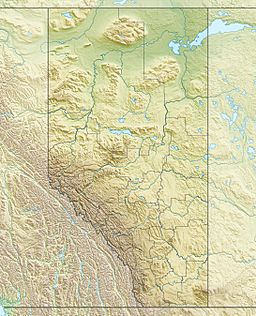Mount Jimmy Simpson facts for kids
Quick facts for kids Mount Jimmy Simpson |
|
|---|---|

Mt. Jimmy Simpson in winter (2013)
|
|
| Highest point | |
| Elevation | 2,966 m (9,731 ft) |
| Prominence | 251 m (823 ft) |
| Parent peak | Mount Thompson (3089 m) |
| Listing | Mountains of Alberta |
| Geography | |
| Location | Banff National Park Alberta, Canada |
| Parent range | Waputik Mountains Canadian Rockies |
| Topo map | NTS 82N10 |
| Geology | |
| Age of rock | Cambrian |
| Type of rock | Sedimentary |
| Climbing | |
| First ascent | 1897 by J. Norman Collie, G.P. Baker, P. Sarbach |
Mount Jimmy Simpson is a tall mountain peak in the beautiful Canadian Rockies. It stands 2,966-metre (9,731-foot) high! You can find it about 3 kilometres (1.9 miles) northwest of Bow Lake inside Banff National Park in Alberta, Canada.
This mountain is part of the Waputik Mountains. It sits east of the Wapta Icefield and west of the Bow River valley. You can easily spot Mount Jimmy Simpson from the Icefields Parkway when you are at Bow Lake. There's also a smaller peak nearby called Jimmy Simpson Junior, which is 2,721 meters tall.
Contents
Who Was Jimmy Simpson?
Mount Jimmy Simpson is named after a famous person named Jimmy Simpson (1877–1972). He was an important outfitter who helped explorers travel through the Canadian Rockies a long time ago.
Jimmy learned how to guide and outfit from other experienced people like Bill Peyto. In 1902, he led a big climbing trip for James Outram into the areas around the North Saskatchewan River and Columbia Icefield.
Jimmy built a small log cabin by Bow Lake. He used it for his outfitting business. This cabin was made bigger in 1937 and is now a famous place called Num-Ti-Jah Lodge. Jimmy kept guiding people until after World War II, when his son, Jimmy Simpson Junior, took over the family business.
First Climbers
The very first ascent of Mount Jimmy Simpson happened in 1897. The climbers were J. Norman Collie, George Percival, and Peter Sarbach. The mountain was officially given its name in 1973 by the Geographical Names Board of Canada.
Mountain Rocks
Like other mountains in Banff Park, Mount Jimmy Simpson is made of sedimentary rock. This type of rock formed from layers of sand, mud, and shells that settled at the bottom of ancient shallow seas. Over millions of years, these layers hardened into rock.
Later, during a time called the Laramide orogeny, these rocks were pushed up and folded. This created the tall mountains we see today.
Mountain Weather
Mount Jimmy Simpson has a subarctic climate. This means it has very cold, snowy winters and mild summers. Temperatures can drop below −20 °C, and with the wind, it can feel even colder, below −30 °C. The snow and rain that fall on Mount Jimmy Simpson eventually flow into the Bow River, which is a branch of the Saskatchewan River.
Gallery
Images for kids







